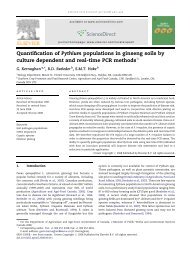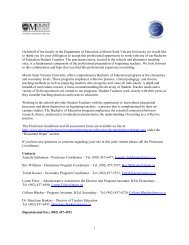Annotated Bibliography On The Social Economy
Annotated Bibliography On The Social Economy
Annotated Bibliography On The Social Economy
- No tags were found...
Create successful ePaper yourself
Turn your PDF publications into a flip-book with our unique Google optimized e-Paper software.
<strong>Annotated</strong> <strong>Bibliography</strong><strong>On</strong><strong>The</strong> <strong>Social</strong> <strong>Economy</strong>(with special reference to communications)Christine AbbottSir Wilfred Grenfell College/Memorial University ofNewfoundlandResearch supported by the Community Services Council,Newfoundland and Labrador and the Student Work and ServiceProgram Labrador
April 2006
Produced for the Communications Node of the <strong>Social</strong> <strong>Economy</strong>and Sustainability Project, MSVU<strong>The</strong> focus for this annotated bibliography was to provide a listing of resources on the<strong>Social</strong> <strong>Economy</strong> with special reference to communications. <strong>The</strong> resulting 78 entriescover the bases from academic articles and books to journal articles to online resources.<strong>The</strong> annotations provide background summaries of the sources, which should help thoseinterested in this area to judge the relevance of the original material to their own needs.
Abramson, Alan and Lester Salamon. 2005. <strong>The</strong> Nonprofit Sector and the FederalBudget: Fiscal Year 2006 and Beyond. Working Paper Series. New York:Nonprofit Sector Research Fund, <strong>The</strong> Aspen Institute. Available online.<strong>The</strong> focus is on the United States. <strong>The</strong> authors examine the new fiveyear budget plansdeveloped by President Bush for the fiscal year 2006 and beyond, and suggest theirpotential impact on that country’s nonprofit organizations. <strong>The</strong>y conclude that toughtimes may be ahead for many nonprofit organizations.Ahmed, Shamima. 2005. Desired Competencies and Job Duties of Nonprofit CEOsin relation to the Current Challenges: Through the lens of CEOs’ JobAdvertisements. Journal of Management Development, 24 (10): 913 – 928.This article uses content analysis to analyze nonprofit CEO job advertisements duringthe 19992004 time periods. <strong>The</strong> aim of the paper is to assess the relevancy andadequacy of the emphasized competencies and job duties to deal with challenges in thissector (accountability, competition, identity). <strong>The</strong> author found that in thoseadvertisements listing an education requirement, the majority required a degree in areasrelated to the nonprofit sector. Under experience, fundraising experience is the mostcommon requirement. Fundraising is also listed as the major job duty.Austin, James E. 200. <strong>The</strong> Collaboration Challenge: How Nonprofits andBusinesses Succeed Through Strategic Alliances. San Francisco, Calif: Jossey– Bass Publishers.A howto book that demonstrates how businesses can strengthen their bottom lines bypartnering with nonprofit organizations, and how nonprofits can use such partnershipsto further their charitable work.Barman, Emily. 2002. <strong>The</strong> Rise of the Donor: Organizational Strategies,Environmental Constraints, and the Field of Workplace Giving. WorkingPaper Series. New York: Nonprofit Sector Research Fund, <strong>The</strong> AspenInstitute. (Available online).
This paper focuses on the effect of competition between nonprofit organizations, on nonprofitorganizations. Through an analysis of the United Way, which once held amonopoly in workplace fundraising, the author addresses the impact of competition onthat organization. It is a comparative analysis of the United Way in the Bay Area (whichhas experienced competition from other nonprofits) and the United Way of Chicago(which has experienced little competition). <strong>The</strong> author concludes that the presence ofcompetition results in more choices being offered to donors to ensure their loyalty. <strong>The</strong>danger in this is that competition directs the attention of the nonprofit away from theconcerns of their clients and towards those of their donors.Beland, Claude. 2000. “<strong>The</strong> Growing Relevance of Cooperative Values andEducation. In Brett Fairbairn, Ian MacPherson, Nora Russell (eds.),Canadian CoOperatives in the Year 2000 ; Memory, Mutual aid, and theMillennium. Saskatoon: Centre for the Study of CoOperatives, Universityof Saskatchewan.This chapter opens with a brief examination of recent changes in banking, includingderegulation and globalization. <strong>The</strong> author argues that the impact of these changes on cooperativescan be minimized if cooperative values and rules are maintained. He suggeststhat the future of cooperatives depends on today’s cooperators: that they continue tooperate according to cooperative values and make a commitment to cooperativeeducation of those values.Belhadji, Bachir. 2001. Socioeconomic Profile of Aboriginal Cooperatives in Canada.Cooperatives Secretariat: Ottawa.This paper is part of a larger research study (A Report on Aboriginal Cooperatives inCanada: Current Situation and Potential for Growth). <strong>The</strong> paper studies key areas ofsocioeconomic performance in Aboriginal cooperatives, and examines that performancein comparison to Canadian consumer coops and retail sector. It finds that almost allresidents are members; that Aboriginal coops are most active in the retail sector; that coopsare consistent form of social business in Aboriginal communities.Benander, Lynne and Tom Webb. 1999. Marketing Our Cooperative Advantage.ICA Congress, Quebec, Available online.This article argues that Marketing the Cooperative Advantage (MOCA) can equalsuccessful business outcomes. <strong>The</strong> authors emphasize the positives of marketing cooperativesand/or credit unions to build membership. <strong>The</strong>y argue marketing coopstrengths can influence consumer behavior when the advantages to the consumer of doingbusiness with the coop are highlighted. For example, participants in this study report awide range of cooperative advantages including; community commitment, distributionof profits, and buying power. Recommendations include developing MOCA as an onlineresource. Ninetysix people and organizations participated in this study.
This chapter focuses on the role of women in cooperatives both historically andcurrently. It provides an overview of the problems women face within established coops.Focusing on research in Nova Scotia as well as globally, it emphasizes thecontributions of previous generations of women within the coop movement. <strong>The</strong> authorargues that the nature of coops dictates that women take leadership positions, and brieflyexplores the need for womenonly cooperatives to achieve this goal.Cabaj, M. 2004. CED & <strong>Social</strong> <strong>Economy</strong> in Canada. Making Waves, 15 (1): 1320.<strong>The</strong> author demonstrates the important connection between the economic and social livesof communities and the various ways communities have worked to revitalize themselves.Initiatives described include; cooperatives, local development associations, andcommunity development corporations. While geographic communities are one area offocus, the author also provides some details about the women’s movement in Canada asan example of a group that fought against economic and social exclusion. Quebec is alsoused as an example of communitybased initiatives, due to its strong communitybasedmovement.Cappellari, Lorenzo and Gilberto Turati. 2004. Volunteer Labour Supply: <strong>The</strong> Roleof Workers Motivations. Annals of Public and Cooperative Economics, 75 (4):619 – 643.<strong>The</strong> determinants of volunteering are examined in this paper. <strong>The</strong> authors examine thenoneconomic incentives to volunteering in Italian workers in three different areas: socialservices, political activism, and union activism. <strong>The</strong>y conclude that the role of extrinsicand intrinsic motivations play a role in voluntary labour supply.Carson, Emmett D. 2002. Public Expectations and Nonprofit Sector Realities: AGrowing Divide With Disastrous Consequences. Nonprofit and VoluntarySector Quarterly, 31: 429 – 436.This article addresses the image problem of nonprofits, and the possible disconnectbetween the public’s expectations of the nonprofit and the reality of the organization. Atall levels, there is a need to present to the public, an accurate picture of operationaldifficulties within nonprofit organizations. <strong>The</strong> author argues that the media must becorrected when any misrepresentation of nonprofits occurs. He states that the averagecitizen has an unrealistic and romanticized vision of what a nonprofit does and whononprofit volunteers are (nonprofits do not always use only volunteers).Chaves, Rafael and Antonia SajardoMoreno. 2004. <strong>Social</strong> <strong>Economy</strong> Managers:Between Values and Entrenchment. Annals of Public & CooperativeEconomics, 75 (1): 139 – 161.
This article focuses on the key role managers play in social economy corporategovernance. In determining the path social economy enterprises take, this articleanalyzes the central role of managers, the nature of these particular human resources, thevariables that influence their behavior and decisions, and their ability to plan andimplement strategies that strengthen or undermine the social economy identity of theseenterprises. It also examines the options for management selection and control.Connolly, Paul & York, Peter. 2002. “Evaluating CapacityBuilding Efforts forNonprofit Organizations.” OD Practitioner, 32 (4): 3339.<strong>The</strong> authors acknowledge that it is difficult to develop measurements of effectiveness fornonprofit organizations since there is no financial ‘bottom line’ to appraise. <strong>The</strong>y argue,however, there are many compelling reasons to evaluate these organizations. Evaluationgenerates new knowledge ad allows for the discovery of what works, for whom, andunder what circumstances. Systematic evaluation helps to increase accountability and tocompare the effectiveness of different activities. This article explains how nonprofitorganizations can evaluate activities, and processes for implementing evaluation methodsand using and sharing results.Connors, Tracy Daniel (ed). 2002. <strong>The</strong> Nonprofit Handbook. 3 rd Ed. New York:John Wiley & Sons.This publication brings together thirtyfive experts in the field of nonprofit managementcovering human resources, information technology, and other issues within the nonprofitcontext. <strong>The</strong>se experts provide policies and procedures applicable to almost every nonprofitorganization. <strong>The</strong>se experts provide policies and procedures applicable to almostevery nonprofit organization. <strong>The</strong>se crucial areas covered include: effectiveness,efficiency, and evolutionary environment. Also included are developments in areas suchas management, organizational identity, effective operating and management strategies,and marketing and communications.Dart, Raymond and Brenda Zimmerman. 2000. “After Government Cuts: Insightsfrom Two <strong>On</strong>tario ‘Enterprising Nonprofits’”. In Keith G. Banting (ed.),<strong>The</strong> Nonprofit Sector in Canada: Roles and Relationships. Montreal &Kingston: School of Policy Studies, McGillQueen’s University Press.This chapter presents two case studies illustrating nonprofit organizations which turned tocommercial ventures and the consequences for them. Noting that revenue fromgovernment sources has declined significantly, the authors examine the positives and thenegatives of turning to ‘business ventures’ in response to the revenue shortfall. <strong>The</strong>authors note that the question of becoming ‘business like’ affects not only the bottomline, but also the public perception of the nonprofit. More importantly, this chapter dealswith the unintended internal consequences on the organization itself. For example, in the
case of the counseling organization, workers described how the ‘type’ of service(counseling) was changed through the process of becoming ‘commercialized’.DaytonJohnson, Jeff. 2001. <strong>Social</strong> Cohesion and Economic Prosperity. Toronto:James Lorimar & Company Ltd.<strong>Social</strong> cohesion is typically viewed as a predominant characteristic of the idealized, tightknit rural community: a characteristic now being undermined by the challenges ofglobalization. <strong>The</strong> author takes social cohesion to a national level and examines the linkbetween social cohesion and economic performance, both in Canada and in countriesaround the world. He concludes that despite the problems caused by globalization, socialcohesion can play an important role in creating prosperous societies today. He suggeststhat because of the dominant position economics holds in our global world, the only wayto demonstrate the value of social cohesion is to demonstrate its economic value.Dees, J. Gregory. 1998. Enterprising Nonprofits. Harvard Business Review(JanuaryFebruary).Because nonprofit organizations are experiencing fewer donations and less governmentsupport, many are turning to revenuegenerating programs. <strong>The</strong> author analyzes therationale of and prospects for those nonprofits, and offers a social enterprise ‘spectrum’.This spectrum runs from purely philanthropic to purely commercial nonprofits: in themiddles are blended organizations. He outlines some risks that nonprofits need tomanage in choosing to seek commercial income. <strong>The</strong>se include the possibility ofalienating volunteers and staff who may not like some of the consequences ofcommercialization.Dees, J. Gregory, J. Emerson, & P. <strong>Economy</strong>. 2001. Enterprising Nonprofits: AToolkit for <strong>Social</strong> Entrepreneurs. New York: John Wiley & Sons.Nonprofit organizations have found that traditional sources of revenue are drying up,thus necessitating the adoption of entrepreneurial behavior and techniques. <strong>The</strong>y are nottrying to turn their nonprofits into businesses, but entrepreneurial skills and attitude areseen as necessities for survival. <strong>The</strong> author argues that elements seen in successful forprofitbusinesses are also required for successful social enterprises. This is a handsonbook which includes lessons in: defining your mission, creating a business plan,identifying opportunities, managing risks, understanding customers, and handling offinances.Dreessen, Erwin. 2001. What We Should Know About the Voluntary Sector butDon’t. Isuma, 2 (2): 1119.
This article calls for more knowledge about the nonprofit sector in general. <strong>The</strong> authorargues that while we have some knowledge about volunteering, major gaps remain in theaccuracy of the data. For example, while we know about individual behavior regardingvolunteering, we know little about volunteering over the life cycle. And we do not knowto what extent data on volunteering are ‘contaminated’ by compulsory programs such ascourtordered community service.Euske, K.J. 2003. Public, Private, NotforProfit: Everybody is Unique? MeasuringBusiness Excellence, 7(4): 511.This article argues that although some individuals maintain that the public, private, andnotforprofit sectors are fundamentally different in many ways, the three sectors havemany similarities. <strong>The</strong> author claims that these similarities present opportunities tointeract and learn from each other. A focus on the similarities rather than the differencescan facilitate the exchange of ideas and learning across the sectors. While solutions manynot always be similar, solutions used in one sector may be of benefit to anotherorganization in another sector.Fairburn, Brett. 2003. Three Strategic Concepts for the Guidance of Cooperatives.Centre for the Study of Cooperatives, University of Saskatchewan.(Available online.)Traditionally, coops have been seen as having objectives that are either ‘social’ or‘economic’. <strong>The</strong> author suggests an integrate approach is more helpful, and presentsthree concepts for thinking about the bridging social and economic objectives. <strong>The</strong>seconcepts are economic linkages, transparency, and cognition. He argues that we mustbuild on the knowledge of past experiences of cooperatives in order to learn how to dealwith changes for the future.Fairbairn, Brett, June Bold, Murray Fulton, Lou Hammond Ketilson & Daniel Ish.1991. Cooperatives and Community Development: Economics in <strong>Social</strong>Perspective. Saskatoon: Centre for the Study of Cooperatives, University ofSaskatchewan.While the focus is on cooperatives and credit unions in Saskatchewan and the Prairies, itapplies elsewhere. <strong>The</strong> book emphasizes the unique roles and functions of cooperativesin communities and within community development. <strong>The</strong> book begins with an historicalcontext of the growth of and need for cooperatives. It is particularly relevant today, as itplaces coops at the community level as a response to globalization and the reduction ofthe power of communities. <strong>The</strong> authors compare coops for profit businesses, andexamine the potential of coops in terms of economic as well as social benefits. Forexample, because coops are not profit driven, they can make other decisions. <strong>The</strong> socialimplication of this is that coops succeed in maintaining services that profitdrivenbusinesses have pulledout of when the service was no longer profitable. <strong>The</strong> text links
the importance of coops to community. For example, community residents tend torecognize the consequences of not supporting the local coop. This is demonstratedthrough a discussion if economic ‘leakages’: that income into a community (wages) mustbe recirculated within that community before it ‘leaks’ out of the community (profits tohead office). Particularly insightful for those in small communities, communities unitedby occupation, and communities with needs not met by the government. <strong>The</strong> authorsargue in favor of taking the coop route to community development.Fairbairn, Brett, Ian MacPherson and Nora Russell (eds.). 2000. Canadian Cooperativesin the Year 2000: Memory, Mutual Aid and the Millennium.Saskatoon: Centre for the Study of Cooperatives, University ofSaskatchewan.This publication provides a history of the Canadian cooperative movement. It examinesthe current state of this movement in terms of housing coops, women in Canadian cooperativesand healthcare sector in Quebec. <strong>The</strong> authors examine the emergence of anew cooperative paradigm and the growing relevance of cooperative values andeducation. Discussion includes the challenges of marketing cooperative in a globalsociety; how the movement adjusts to change, past and present, and what it will have todo in the future. <strong>The</strong>y conclude there is no one model of coop, and emphasize theimportance of leadership required for new challenges. <strong>The</strong> essays are based on cooperativeleaders’ experiences as well as some theoretical work by academics.Frumkin, Peter. 2000. Philanthropic Leverage. Society, Vol. 37, 4048. TransactionPublishers.Following the adage “Give a man a fish and you feed him for a day. Teach a man to fishand you feed him for a lifetime,” this article argues that nonprofit organizations mustunderstand donation from the donor’s perspective. If the nonprofit can demonstrate todonors that by giving them a dollar, they will help them (the organization) become selfsustainable, then the donor will be more likely to give to that organization as opposed toan organization that will continue to ask for donations.Fulton, Murray. 2000. “A Systems Approach to the Challenges Facing CooperativeEducation and Cooperatives.” In Brett Fairbairn, Ian MacPherson, NoraRussell (eds.), Canadian CoOperatives in the year 2000 : Memory, MutualAid, and the Millennium. Saskatoon: Centre for the Study of CoOperatives,University of Saskatchewan.This chapter analyzes cooperatives and cooperative education as part of a network orsocial organization. From this perspective, the essay examines the importance of cooperativeeducation within the emerging knowledge economy. He argues that the very
notion of a knowledge economy suggest greater weight should be placed on knowledge,thus, education should be a key element for cooperatives.Gill, Carmen and Luc <strong>The</strong>riault. 2001. State Recognition of Family Violence ServicesDelivered by Women’s Shelters in Saskatchewan. Occasional Papers, No. 14.Regina: <strong>Social</strong> Policy Research Unit, University of Regina.This is an exploratory study focusing on women’s shelters in Saskatchewan. <strong>The</strong> authorsinterviewed directors of women’s shelters to examine the relationship between thedirectors and public officials. <strong>The</strong> focus is on the positive and negative factors impactingdelivery of services because they are funded by the government. Negatives include thedifficulty in applying for funding grants at the provincial level, a public perception thatthey are operating on behalf of the apartment of <strong>Social</strong> Services, and not enoughautonomy in running their operations. <strong>The</strong> positive is seen in the recognition ofgovernment’s determination to eradicate violence against women.Gill, Carmen and Luc <strong>The</strong>riault. 2003. Valuing Volunteering Without Recognizingthe Reality of the Voluntary sector. Canadian Review of <strong>Social</strong> Policy, 51,132136.An examination of the proposed framework as put forth by the Government ofSaskatchewan (2002) (Voluntary Sector Initiative: Framework for Partnership BetweenGovernment and the Third Sector). <strong>The</strong> authors argue that the framework is too narrowin focus and not inclusive enough of the entire sector. While many voluntaryorganizations rely on volunteer boards of directors, they are also dependent onprofessional paid staff. <strong>The</strong>y argue that government must recognize the sector as a wholeand not just focus on the time spent by volunteers. Government must also focus on theworking conditions within these organizations,Girard, JeanPierre. 2000. “CoOp Activities in the Health and <strong>Social</strong>Care Sectorin Quebec”. In Brett Fairnbairn, Ian MacPherson, Nora Russell (eds.),Canadian CoOperatives in the Year 2000 : Memory, Mutual Aid, and theMillennium. Saskatoon: Centre for the Study of CoOperatives, University ofSaskatchewan.<strong>The</strong> chapter discusses the role of the Quebec government in the development of socialhealth care. <strong>The</strong> description of the cooperatives and their members – user, worker andorganizational – is helpful in understanding the structure of health care cooperatives inthat province.Goldblatt, Mark. 2000. “Canada’s Nonprofit Cooperative Housing Sector: AnAlternative That Works”. In Brett Fairbairn, Ian MacPherson, Nora Russell
(eds.), Canadian CoOperatives in the Year 2000: Memory, Mutual Aid, andthe Millennium. Saskatoon: Centre for the Study of CoOperatives,University of Saskatchewan.This chapter examines the role of the nonprofit cooperative housing sector in Canadadetailing the characteristics and development of housing cooperatives, their historicaldevelopment, ad the role of government financing. It includes profiles of four womenleaders in this movement in British Columbia, Alberta, Quebec, and <strong>On</strong>tario. <strong>The</strong> chapterconcludes with an overview of the prospects for nonprofit cooperative housing in thefuture.Griffiths, David. 2003. Why Do Cooperatives Fail as Cooperatives? <strong>The</strong> CooperativeFederation of Victoria Limited. (Available online.)In examining the failure of some cooperatives, the author begins by differentiatingbetween ‘economic’ failure and ‘cooperative’ failure. While economic failure isgenerally seen as failing as a viable business, unable to compete and generate profits, ‘cooperative’failure is more complex. <strong>The</strong> author argues that while a cooperative maycontinue as a successful business – competitive, profitable and growing – it fails as a cooperativewhen it ceases practicing cooperative vales and principles, irrespective of itseconomic viability. <strong>The</strong> ingredients of failure exist in all cooperatives; however, cooperativefailure is not inevitable.Hall, Michael H. et al. (2005). <strong>The</strong> Canadian Nonprofit and Voluntary Sector inComparative Perspective. Toronto: Imagine Canada. (Available online).A collaborative effort between Imagine Canada and Johns Hopkins University, this reportdetails findings within the Canadian nonprofit sector, and provides a comparison of theCanadian sector with nonprofit sectors in 36 other countries around the world. <strong>The</strong>report outlines five structuraloperational features broadly defining social economy:organized, private, not profit distributing, self governing, and voluntary. This definitionis applicable to Canada’s sector which encompasses ‘service delivery’ in health,education, and social services. As a country with one of the largest and most vibrantsocial economy sectors in the world, Canada differs from others in terms of its strong,volunteer presence. However, two areas of concern are highlighted: government fundingis now short term only, and Canadians in general are now less willing to give of theirtime and energy.Hopkins, Liza, J. Thomas, D. Meredyth & S. Ewing. Nov 2004. <strong>Social</strong> Capital andCommunity Building Through and Electronic Network. Australian Journalof <strong>Social</strong> Issues, 39 (4): 369379.
This paper describes a social policy experiment in Australian public policy; theimplementation of a “wired community” set up in a lowincome public housing area by anotforprofit internet service provider. This project is meant to test the proposition thatcomputer networks can promote development participation in local communities. <strong>The</strong>authors draw on the concept of social capital; the invisible bonds that connect people andallow people to work together for the good of the group rather than the benefit of theindividual. This paper examines some of the elements which make up community andconsiders the potential for electronic media to contribute to the wellbeing of socialgroups. While the wired community is attractive to policymakers and funding bodies, itseems evident that lowincome people who are social and economically excluded wouldbenefit from greater “connectedness” with one another.Inglis, Sue, Ted Alexander, and Liz Weaver. 1999. “Roles and Responsibilities ofCommunity Nonprofit Boards. Nonprofit Management and Leadership, 10(2): 153 – 167.In this study, the roles and responsibilities associated with nonprofit boards of directorsare presented within a framework that includes Strategic Activities, Operations, andResource Planning roles. This can be valuable for paid staff as well as volunteers inunderstanding the broad scope of the work of nonprofit boards. Practical applicationssuch as agenda setting for board meetings and designing board training and developmentactivities are included.Institute for Media, Policy and Civil Society. Developing Effective MediaCommunication Skills. Activate. Available online.A short but practical article which covers the importance of dealing with the media fornonprofit organizations. It includes the importance of preparing a spokesperson and astepbystep guide to preparing a spokesperson.Institute for Media, Policy and Civil Society. Developing Effective MediaCommunication Skills. Activate. Available online.Like it or not, ‘branding’ is as important for nonprofit organizations as it is in the forprofitsector. Why do nonprofits need a brand? <strong>The</strong> article argues that nonprofitorganizations must ‘brand’ or‘rebrand’ to be noticed and to take their place in the overalleconomy. Discusses the importance of ‘brand management’ between the nonprofit andits audience in terms of ‘valuebased’ branding. This article includes case studies oforganizations which found it necessary to rebrand; Oxfam International and MuscularDystrophy Canada.Institute for Media, Policy, and Civil Society. IMPACS Media CommunicationsToolkit. Activate. Available online.
This source argues that media communications should not be an afterthought for nonprofitorganizations, but rather a key tool in achieving the organization’s objectives. Itpresents common media tools for using various media to increase the public profile of thenonprofit, and includes how to use these tools and why.Jenson, Jane and Susan D. Phillips. 2000. “Distinctive Trajectories: Homecare andthe voluntary Sector in Quebec and <strong>On</strong>tario” in Keith G. Banting (ed.), <strong>The</strong>Nonprofit Sector in Canada: Roles and Relationships. Montreal & Kingston:School of Policy Studies, McGillQueen’s university Press.A study of the emergence of two distinct ways of restructuring the delivery of homecareservices. <strong>On</strong>tario and Quebec are the focus of this chapter: two provinces whichemphasize home care over institutional care, albeit with different policies. Quebec:CLSC (centre local des services communitarians) and <strong>On</strong>tario: CCAC (Community CareAccess Centres). This essay illustrates that both organizations straddle the borderbetween the public and nonprofit sectors, with nonprofit and government playersperforming interconnected roles. Toward the end of the 20 th century, the government of<strong>On</strong>tario continued to rely on mixed publicprivate provision and a major role fornonprofit agencies with volunteer boards. It continued to reinforce the role of nonpublicagencies to deliver these services. At the same time, Quebec was turning away from nonpublicagencies as ‘separate systems’ and culminating relationships with the voluntarysector, calling for more community development, more local involvement, lesscentralization, and less institutionalization.Juillet, Luc et al. 2001. “<strong>The</strong> Impact of Changes in the Funding Environment onNonprofit Organizations”. In Kathy L. Brock and Keith G. Banting (eds.),<strong>The</strong> Nonprofit Sector and Government in a New Century. Montreal &Kingston: School of Policy Studies, McGillQueen’s University Press.As funding sources change, nonprofits must experiment with new forms of acquiringrevenues. How does this pressure to respond to changes in the funding environmentimpact these organizations? Eight organizations are studied; two from each ofenvironmental groups, health and social services groups, international developmentgroups, and women’s groups. Each organization experienced fluctuating levels offunding from government, corporate donations, commercial activities, feeforservicecontracts, and so on. <strong>The</strong> authors analyze the impact on each organization’s (1) mission,(2) governance, and (3) program delivery. <strong>The</strong>y conclude that the impact is not as severeas suggested in much of the existing literature: that despite the financial pressures, theseorganizations were successful in resisting change and maintaining stability in theirprograms.Ketilson, Lou Hammond. 2000. “Cooperative Leadership in the New Millennium”.In Brett Fairbairn, Ian MacPherson, Nora Russell (eds.), Canadian Co
Operatives in the Year 2000: Memory, Mutual Aid, and the Millennium.Saskatoon: Centre for the Study of CoOperatives, University ofSaskatchewan.With a focus on Saskatchewan, this chapter considers the characteristics required ofleaders of cooperatives and credit unions in urban and rural settings. <strong>The</strong> idea of theneed for collaboration during these challenging times is examined within the context ofleadership characteristics and skill, and the community.Ketilson, Lou Hammond and Ian MacPherson. 2001. A Report on Aboriginal Cooperativesin Canada: Current Situation and Potential for Growth. Saskatoon:Centre for the Study of Cooperatives, University of Saskatchewan.This detailed report reviews the current state of Aboriginal cooperatives in Canada, andexamines the applicability of the model in aboriginal community settings. Included are aseries of case studies. Conclusions regarding the success of these enterprises are offeredad recommendations for future development are outlined.Kunreuther, Frances. 2003. <strong>The</strong> Changing of the Guard: What GenerationalDifferences Tell us about <strong>Social</strong>Change Organizations. Nonprofit andVoluntary Sector Quarterly, 32: 450 – 457.This article addresses the issue of generationgap problems in nonprofits that threatentheir survival. Indepth interviews with executive staff and young workers wereconducted, and while they have many of the same personal qualities, their motivation forparticipation is different. Younger workers are characterized as trying to change thesystem, whereas, older workers work within it. Recommendations include: support foryounger workers; making active development of younger staff a priority, and recognizingthe contributions of younger workers.La Piana, David & Michaela Hayes. 2005. M&A in the Nonprofit Sector: ManagingMerger Negotiations and Integration. Strategy & Leadership, 33 (2): 1116.This article provides a variety of tools to help nonprofit organizations determine whetherto undertake merger negotiations, how to facilitate these negotiations, and how tointegrate the postmerger organizations. <strong>The</strong> authors interviewed board members of nonprofitsthat have merged and found that the critical point in the merger process occurs inthe negotiation phase. This is where board members play a key role. This article alertsvolunteer board members to the differences between mergers in the nonprofit sector andin the forprofit sector. For example, in the nonprofit sector, merger means partnership;in the forprofit sector, merger means acquisition. For those contemplating mergers, thisarticle provides a stepbystep guide.
Lasby, David & David McIver. 2004. Where Canadians Volunteer: Volunteering byType of Organization. Toronto: Canadian Centre for Philanthropy &Volunteer Canada.<strong>The</strong> importance and economic value of Canadian volunteers in the nonprofit sectorcannot be understated. Drawing on data from the National Survey of Giving,Volunteering and Participating (NSGVP), this report examines volunteering amongstCanadians and addresses the following questions: who volunteers, why do they volunteer,why do they volunteer for a particular organization . <strong>The</strong> authors focus their analysis onfour specific types of organizations; Arts, Culture and Recreation, <strong>Social</strong> Service,Religious, and Educational organizations. <strong>The</strong> findings indicate that the likelihood ofvolunteering varies according to: organization type, method of initial involvement, anddemographics. <strong>The</strong>se findings can assist organizations that rely on volunteers to targettheir recruitment efforts.Leonard, Rosemary, Jenny <strong>On</strong>yx & Helen HaywardBrown. Spring 2005. QualityGifts: Issues in Understanding Quality Volunteering in Human Services.Australian Journal of <strong>Social</strong> Issues, 40 (3): 411425.<strong>The</strong> Australian government has set new requirements for funding for organizationsproviding human services. As result, there is increased pressure for these organizationsto demonstrate the quality of their services. Four dimensions of ‘quality’ illustrate someof the contradictions surrounding these governmental expectations. Using focus groupsand individual, indepth interviews in the areas of health services, palliative care, familysupport, day care, disability, and youth services, the authors examine the notion of‘quality’ from the perspective of clients, volunteers, and coordinators. Clients andvolunteers perceptions of quality focused on strong, trusting, personal relationships. Coordinatorsused a combination of approaches to try to satisfy the demands of both clientsand volunteers, as well as the bureaucracy.Lewis, Dianne S, Erica French & Peter Steane. 1997. A Culture of Conflict.Leadership & Organization Development Journal, 18 (6): 275 – 282.This article uses the example of a small, nonprofit organization where conflict betweenthe volunteers and paid workers, and among the volunteers themselves becomes the overridingconsideration in decision making, thus, paralyzing the organization. While conflictmay be an incentive for action (and therefore helpful), it can also be damaging when itbecomes the dominant feature in a nonprofit organization. This internal conflict has thepotential to impact on goalsetting, staffing, the conduct of meetings, problem solvingand decision making and the writing of submissions for government funding.Lewis, M. 2004. Common Ground: CED & the <strong>Social</strong> <strong>Economy</strong> – Sorting Out theBasics. Making Waves, 15(1): 711.
This article explores “the points of convergence and divergence between the territorialapproach of CED and enterprise focus of the social economy.” Lewis lists ten social andeconomic tasks important to building local economies. <strong>The</strong>se include: social supports,education, health, infrastructure, accessible credit, and local ownership. Lewis calls for acombination of efforts to realize community development goals.Masaoka, Jan, Jeanne Peters & Stephen Richardson. 2002. A House divided: HowNonprofits Experience Union Drives. Working Paper Series. New York:Nonprofit Sector Research Fund, <strong>The</strong> Aspen Institute.Generally, most nonprofit organizations are viewed as struggling with a lack ofgovernment funding, with an increased need for funds, and of late, with increasedcompetition for funds. <strong>The</strong> authors argue that government contracts as a source offunding is often the impetus for union organizing within a nonprofit. While careful notto take sides in the debate, indepth interviews were conducted to examine the power of aunion drive to divide an organization.Meinhard, Agnes G., & Mary K. Foster. 2003. Differences in the Response ofWomen’s Voluntary Organizations to Shifts in Canadian Public Policy.Nonprofit and Voluntary Sector Quarterly, 32(3): 366396.Through a gender lens, this paper investigates differences in attitudes, behaviors, andadaptation to the changing climate within the nonprofit sector. Women’s voluntaryorganizations are generally categorized as organizations run by women for women;however, in this paper the authors define any organization with a governing boardcomposed of at least two thirds female as a women’s organization. Using selfreportsurvey data, they compare ‘women’s’ organizations with ‘gender neutral’ organizationsin terms of their response to current challenges. <strong>The</strong> findings reveal women’sorganizations (as defined by the authors), are less likely to adopt businesslike strategiesand are more likely to collaborate with others. Women’s organizations are also morecritical of government policies, following “the long tradition of women’s organizationsagitating for their own rights as well as those of the needy and downtrodden.”Mitchell, Darcy, Justin Longo & Kelly Vodden. 2001. “Building Capacity orStraining Resources? <strong>The</strong> Changing Role of the Nonprofit Sector inThreatened Coastal Economies”. In Kathy L. Brock and Keith G. Banting(eds.), <strong>The</strong> Nonprofit Sector and Government in a New Century. Montreal &Kingston: School of Policy Studies, McGillQueen’s University Press.<strong>The</strong> study area is the Northern Vancouver Island region of British Columbia which is arural, resource dependent area (fishing, lumber, minerals). This chapter looks at the ruralcommunity level and studies agencies concerned with: economic development, naturalresource management, and the environment. <strong>The</strong> authors hypothesize that the withdrawal
of government from the provision of services would encourage local collaborative effortsby community agencies, thereby enhancing social cohesion. However, they conclude theeffect has actually weakened local and nonprofit sectors. <strong>The</strong>y examine threecollaborative organizations and find that they tend to be advisory, failing to give localcommunities little power over local resources. <strong>The</strong>y found that the creation ofcollaborative organizations as intermediaries between community and government mayhelp governments more than it does local communities.Murray, Vic, Pat Bradshaw and Jacob Wolpin. 1996. “Women on Boards ofNonprofits: What Difference Do <strong>The</strong>y Make?” Nonprofit Management andLeadership, 6 (3): 241 – 254.In this article, the authors explore the impact of women on nonprofit boards. <strong>The</strong>y lookat the actual proportion of women on boards and at the sex of the chief executive officersin order to examine the impact of these variables on effectiveness, structure, and process.Based on data from a crosssection of Canadian nonprofits, the results indicate that asthe percentage of women on a board increases, the dynamics of the board aresignificantly affected.Neamtan, N. 2004. <strong>The</strong> Political Imperative: Civil Society & the Politics ofEmpowerment. Making Waves, 15 (1): 2630.Neamtan demonstrates how community economic development (CED) corporations areindicative of a desired shift by many Canadians towards inclusiveness and collaboration.Quebec is presented as a province in which “social economy is one of the strongest andmost visible progressive movements”. She argues that changes elsewhere will only occurwhen people are in control, collaborating and creating alliances. Required changes alsoinclude a rethinking of progressive governance.Ninacs, William A. 2000. “<strong>Social</strong> <strong>Economy</strong>: A Practitioner’s Viewpoint”. In EricShragge and JeanMarc Fontan (eds.), <strong>Social</strong> <strong>Economy</strong>: InternationalDebates and Perspectives. Montreal: Black Rose Books.This chapter is a ‘bottomup’ analysis which examines Quebec’s social economy from apractitioner’s point of view. It includes women’s groups, the communitarian movement,the cooperative movement, and the labour movement. <strong>The</strong> author concludes that whileQuebec’s track record is positive, many groups continue to face dilemmas as the socialeconomy remains marginal in terms of economic development. He argues that it’spotential to take its place within the traditional economy, as a tool to eliminate socialinequality as opposed to simply ‘managing’ it, is not recognized by government.OECD. 2003. <strong>The</strong> Nonprofit Sector in a Changing <strong>Economy</strong>. Paris, France:Organization for Economic CoOperation and Development.
Countries examined in this book include EU countries, USA, Mexico, Canada (Quebec),and Australia. Common trends are found in the nonprofit sector in each of thesecountries: the sector is becoming more entrepreneurial and less dependant on publicfunding. <strong>The</strong> publication provides evidence of the sector becoming innovative in raisingmoney by adapting its management methods to cope with constraints and opportunitiesarising from economic and social trends. At the same time, the major challenge to thesector in each country is to not loose its distinctiveness. <strong>The</strong>mes include: innovativetrends in different geographical zones; hw this sector is financed in each country; anevaluation of the sector in terms of social value and its contribution to economicdevelopment; and the interdependence between this sector and other sectors of theeconomy. While this sector has grown in importance in each country, its place is stillsomewhat limited. A gap clearly exists between the role of the nonprofit sector at thelocal level and the recognition it receives at the national level.Padanyi, P. and B. Gainer. 2003. Peer Reputation in the Nonprofit Sector: Its Rolein Nonprofit Sector Management. Corporate Reputation Review, 6 (3), 252 –265.This paper examines the importance of reputation to nonprofit organizations. Anyorganization has several different reputations. Managers of nonprofits need to thinkbeyond how their organization is perceived by the general public and be aware of thereputation of their organization among different key interest groups. This paper examinesthis issue through a set of the relationship between peer reputation and other nonprofitperformance variables. It provides evidence that an organization’s reputation amongmanagers if similar nonprofit organizations influence its success in attracting resources.It also provides evidence that an organizations peer reputation is affected by other nonprofitperformance factors such as client satisfaction.Quarter, J. 1992. Canada’s <strong>Social</strong> <strong>Economy</strong>, Cooperatives, Nonprofits, and OtherCommunity Enterprises. Toronto: Lorimer.Viewed as a portion of the economy that falls between privatesector business and statecorporations owned by governments, the social economy can be described as the ‘bridge’between social policy and economic policy. <strong>The</strong> author begins by describing the socialeconomy, its key components and common dimensions. While the focus is on Canada’ssocial economy, there are international examples which have had an impact in thiscountry. Focusing on cooperatives and nonprofits, case studies are presented in the areasof housing, healthcare, childcare, and regional development. <strong>The</strong> author explores newapproaches to ownership and management, new ways of managing social services, andnew forms of ownership.Quarter, Jack, B.J. Richmond, Jorge Sousa and Shirley Thompson. 2001. “AnAnalytic Framework for Classifying the Organizations of the <strong>Social</strong>
<strong>Economy</strong>”. In Kathy L. Brock and Keith G. Banting (eds.), <strong>The</strong> NonprofitSector and Government in a New Century. Montreal & Kingston: School ofPolicy Studies, McGillQueen’s University Press.This chapter addresses the complex issue of classifying organizations in the socialeconomy. In the past, organizations have generally been classified on a onedimensionalsystem (their type of incorporation or type of service). This study employs a multidimensionalapproach using five dimensions: social objectives, relationship togovernment, relationship to the market, democratic decision making, and volunteerparticipation. This preliminary study illustrates that not all social organizations are alike.It provides evidence of the diversity within the social economy and the complexity ofrelationships between cooperatives and nonprofits, and between politics and theeconomic system.Quarter, J., L. Mook, & B. J. Richmond. 2003. What Counts? <strong>Social</strong> Accounting forNonprofit and Cooperatives. New Jersey: Prentice Hall.An integrated approach used in this book broadens financial accounting by building in‘social’ variables. While traditional accounting procedures focus on financialconsiderations, this text acknowledges the broader considerations of social inputs andsocial outputs. This text presents new tools of analysis which are adaptations of threetraditional financial accounting reports: the income statement, the balance sheet, and thevalue added statement. Additionally, it includes a Community <strong>Social</strong> Return onInvestment model (chapter 4) to enable social organizations to measure their socialimpact. A unique feature of the text is the integration of important nonmonetized itemsinto accounting statements by assigning an appropriate value to those items that do notinvolve market transactions. Chapter 8 presents a social accounting toolkit that explainshow to assess outputs and other social variables. It offers detailed examples on how toassess volunteer functions, how to assign a market value to them, and how to identifysocial outputs and place a value on them. <strong>Social</strong> accounting can create a deeperappreciation of the contribution of these organizations, not only for the community atlarge, but for those who work and volunteer at these nonprofits. Chapter 9 discussescautions and the limitations of social accounting.Rawsthorne, Margot. Winter 2005. Community Development Activities in theContext of Contracting. Australian Journal of <strong>Social</strong> Issues, 40 (2): 227240.In Australia, relations between the government and community sector organizations haveundergone change. Funding arrangements have changed and contract with serviceexpectations, performance measurements and reporting requirements have beenintroduced. This article examines the experience of community sector organizations toexplore how contractual arrangements have affected some aspects of their communitydevelopment activities. Potential negative impacts include: repositioning communityorganizations as ‘service providers’; the erosion of organizational autonomy; a loss of
mission and purpose; a loss of cooperation and collaboration between organizations inan increasingly competitive environment. This article finds that while contracting hasbeen detrimental to some organizations, overall, the adverse impacts have been less thananticipated.Richard, P. 2004. Transformed by Community Economic Development: SouthwestMontreal Now Has a Future as Well as a Past. Making Waves, 15(1): 2125.<strong>The</strong> author explains the establishment of RESO (a community development organization)and its various activities in moving Southwest Montréal from a devastated area to aregion looking at sustainable development and revival. Democracy and collaboration arehighlighted as keys to community economic development. Challenges such aspartnerships with public agencies and attaining financial autonomy are also mentioned.Scanlan, Eugene A. 2002. Strategic Task Forces. International Journal of Nonprofitand Voluntary Sector Marketing, 7 (4): 334342.A case study is presented to demonstrate how the use of ‘Strategic Task Forces’ is aneffective way to address immediate needs of nonprofit organizations. For example,marketing to build awareness and recognition or to specifically raise funds, or developinghighly networked new volunteers. This strategy is seen as particularly effective inmeeting these challenges which cannot be resolved by staff, board members and othervolunteers.Simon, Judith Sharken, J. Terence Donovan. 2001. <strong>The</strong> Five Stages of NonprofitOrganizations: Where You Are, where You’re Going, and What to ExpectWhen You Get <strong>The</strong>re. Saint Paul, MN: Amherst H. Wilder Foundation.This book was written to help notforprofit leaders and managers, board members, anddonors. <strong>The</strong> authors present a model for the five life sages of nonprofit organizations tohelp them understand their organization’s status ad prepare it to move ahead in the future.<strong>The</strong> life stage concept of organizational assessment is a great tool for objectivelyobserving where a nonprofit is and where it might be headed.Sinats, Kristen. 2001. Health CoOperatives: A viable Solution to the Current Crisisin Health Service Delivery. Victoria, British Columbia: British ColumbiaInstitute of Cooperative Studies.This paper describes cooperative community models of health care and suggests thatthey offer a promising solution to the current crisis in Canadian health care system. Suchcooperatives could be owned by consumers or workers. <strong>The</strong> author argues that userownedhealth cooperatives could be particularly useful for groups with special needs.
She also discusses ways in which these cooperatives could be integrated into the existinghealth care system.Sutherland Kate. 2004. Innovative CoOps in the <strong>Social</strong> Services Sector: A ResearchStudy to benefit People With Developmental Disabilities and Mental Illness.Cooperative Secretariat, Government of Canada.This article addresses innovation in providing service to individuals with a developmentaldisability or mental illness. It details case studies of five social cooperatives and onenonprofit organization that provide services to these individual. <strong>The</strong> author argues thatsocial cooperatives can be effective structures to address the needs and goals of thesegroups of disabled people. Several conclusions emerge: there is tremendous potential forcommunity benefit from this innovation; governments focus on nonprofit associations tothe exclusion of social cooperatives; the potential of the social cooperative is underrealized.Taylor, M. & J. Lewis. 1997. “Contracting: What Does it Do to Voluntary andNonprofit Organizations?” In Perri 6 and J. Kendall (eds.), <strong>The</strong> ContractCulture in Public Services. London: Arena.This contains four studies of nonprofit organizations in London, England wheregovernment support is moving away from grants to a culture of contracting. It examinesimplications for goals, management structure, and the relationship of nonprofits withlocal governments. This is preliminary work in this area, but it is clear that nonprofitsand voluntary organizations feel anxious about contracts. This chapter asks how thechange in funding relationship affects the nonprofit organization; are the changes solelyas a result of contracting, and how will this ‘culture of contracts’ impact the sector. <strong>The</strong>authors conclude that the move to contracting has negative impacts on this sector. <strong>The</strong>senegative impacts include: contracts use more time and resources; those organizations whowant to move to contracts must be able to compete; the impact of contracting versus'grants' in term of government funding; the focus on price per unit of service versusquality of service and its social purpose; winning contracts often means deliveringservices according to government mandates which may lead to changes in types ofservices and the clients that they serve. <strong>The</strong> advantage of grants is that nonprofitsidentify social needs, whereas, with contracts it is government agendas which identifysocial needs. Ultimately, the authors argue that the nonprofit/voluntary sector should be‘complementary’ to other sectors, but this move toward contracts moves nonprofits fromcomplementary status to alternative in providing services, with government determiningthe conditions under which the organizations must provide the services.Tindale, Joseph A. and Erin MacLachlan. 2001. “VON “doing commercial”: <strong>The</strong>Experience of Executive Directors with Related Business Development”. InKathy L. Brock and Keith G. Banting (eds.), <strong>The</strong> nonprofit Sector and
Government in a New Century. Montreal & Kingston: School of PolicyStudies, McGillQueen’s University Press.A comparative case design studying three branches of VON Canada: New Brunswick,<strong>On</strong>tario, and Alberta. It examines the challenges facing executive directors as theyattempt to transform their agencies to deal with new market realities. In the face ofdecreasing government revenues, the directors face two choices: to reduce programs or toincrease revenues from nongovernment sources. In this chapter, the VON brancheschoose to expand to include commercial activities. <strong>The</strong>re are similarities as well asdifferences within the three branches studies in terms of how the individual directorsunderstand their experiences with commercialization, the impact on staff, problems withpublic misunderstanding of their nonprofit status, the need to be consteffect, and thechanges in the programs offered.Vailancourt, Y. & L. Tremblay (Eds). 2002. <strong>Social</strong> <strong>Economy</strong>. Health and Welfare inFour Canadian Provinces. (translated by S.A. Stilitz). Montreal/Halifax:Larepps/Fernwood.<strong>The</strong> focus in this publication is the role the social economy has in the provision of healthand welfare services in four Canadian provinces. This entails: Quebec (childcare,homecare, and social housing); <strong>On</strong>tario (commodification of government policies);Saskatchewan (homecare, food banks, and women’s shelters); New Brunswick(environmental and the women’s movement). <strong>The</strong> authors argue that the major crisis inthe welfare state represents not only problems, but also opportunities. <strong>The</strong>y acknowledgethat each province differs in its context of the social economy. <strong>The</strong>re are separateinterests in each province; therefore, while some governments have embraced the socialeconomy, others have distanced themselves from it. Each chapter discusses tensions andcooperation between the different governments (public sector), the market (privatesector), and the informal and social economy.Wall, J., P. Duguay & S. Rohan. 2004. New Synergies: <strong>The</strong> Cooperative Movement,CED & the <strong>Social</strong> <strong>Economy</strong>. Making Waves, 15(1):3236.<strong>The</strong> authors demonstrate how cooperatives have remained important in communitydevelopment initiatives. <strong>The</strong>y also ask where cooperatives fit into the broader context ofcommunity economic development. Four case studies provide example of cooperativesin relation to community economic development and the social economy.Weisbrod, B. A., (Ed). 1998. To Profit or Not to Profit: <strong>The</strong> Commercialtransformation of the Nonprofit Sector. New York: Cambridge UniversityPress.This book examines the consequences of nonprofit organizations shifting from financialdependence on donations to dependence on other forms of revenue. For organizations
considering the pursuit of commercial revenue, the following are considered: how doesthe revenue source affect the organizations behavior; what of the public perception (andof volunteers) that nonprofit is actually forprofit in disguise; what is the impact ofcompetition with private enterprises? Chapter highlights:Chapter 2: competition among nonprofits where only nonprofits competeChapter 4: user fees as a doubleedged swordChapter 7: why and why not convert from nonprofit to for profit (should public moneybe used for private gain?)Chapter 8: studies of consumerism in health servicesChapter 10: studies of consumerism in social servicesWestlund, Hans. 2003. Form or Content?: <strong>On</strong> the Concept of <strong>Social</strong> <strong>Economy</strong>.International Journal o <strong>Social</strong> Economics, 30 (11): 1192 – 1206.This paper discusses the concept of social economy. <strong>The</strong> social economy and thecommercial economy are not polar opposites, but exist on a continuum. In this respect,should the social economy be defined from an organizational perspective or from theaims and objectives are also performed in other forms of the economy: commerciallydominatedactivities contain social elements as ell. <strong>The</strong> author also provides examples ofsocial economic activities that expand, increase their commercialization, and aretransformed into commercial enterprises.Wilkinson, Paul and Jack Quarter. 1996. Building a CommunityControlled<strong>Economy</strong>: <strong>The</strong> Evangeline Cooperative Experience. Toronto: U of T Press.Following the Antigonish tradition of community development through the cooperativemovement, this book examines he success of four cooperatives in the Evangeline regionin Prince Edward Island. In a time of globalization and decentralization, Islanders havesuccessfully combined institutional structures with voluntary grassroots action to createan economy and social infrastructure based largely on cooperatives, nonprofits, andsmall business. <strong>The</strong> strength of this movement comes from cooperation among cooperatives,and their linking together through a second tier cooperative to pursuedevelopment strategies for the entire region. <strong>The</strong> authors propose a framework ofsuccessful community development through cooperatives. Essential elements include:community consciousness (attachment, bonds), empowering activities (promoting selfreliance),and supportive structures (external agencies). This study demonstrates that asmall community is viable in a modern economy.Winkworth, Gail and Peter Camilleri. August 2004. Keeping the Faith: <strong>The</strong> Impactof Human Services Restructuring on Catholic <strong>Social</strong> Welfare Services.Australian Journal of <strong>Social</strong> Issues, 39 (3): 315328.
Church related agencies are major providers of community services in Australia. Thispaper examines human services restructuring and the impact of the shift to contracting ona human service provider. <strong>The</strong> responsibility for service provision has shifted away fromthe government to the nongovernment sector; including a move away from grants basedfunding to highly specified contractual arrangements for the delivery of services. Nonprofitshave responded in diverse ways; however, church related agencies question theextent to which this restructuring threatens the delivery of responsive services.
















